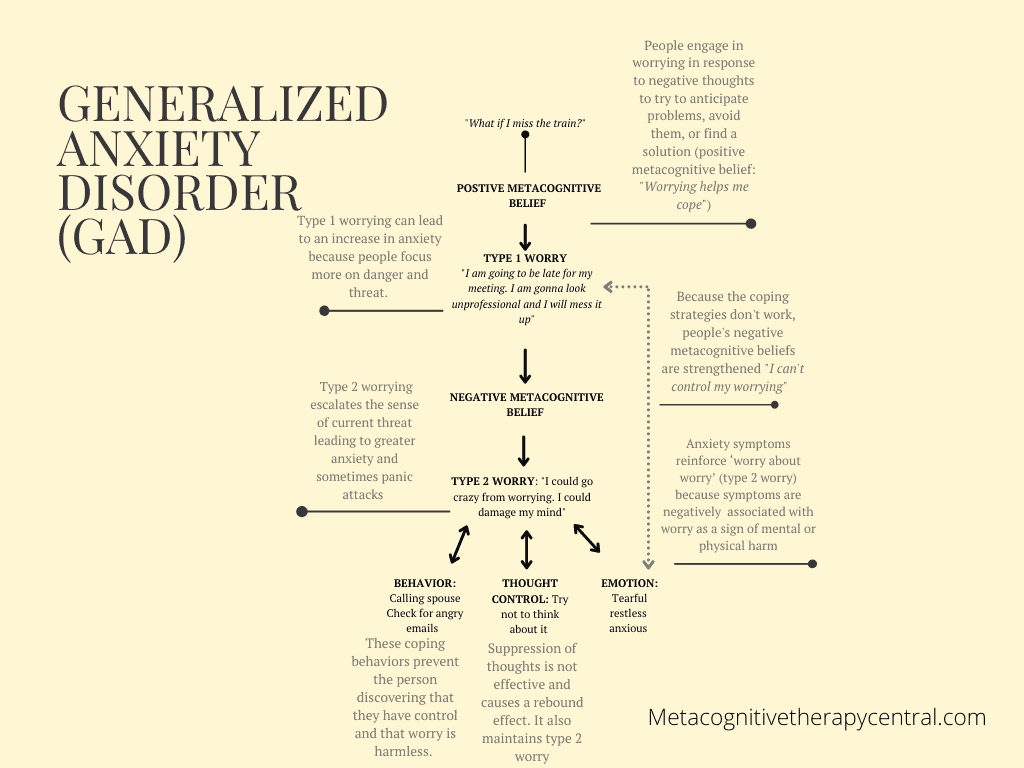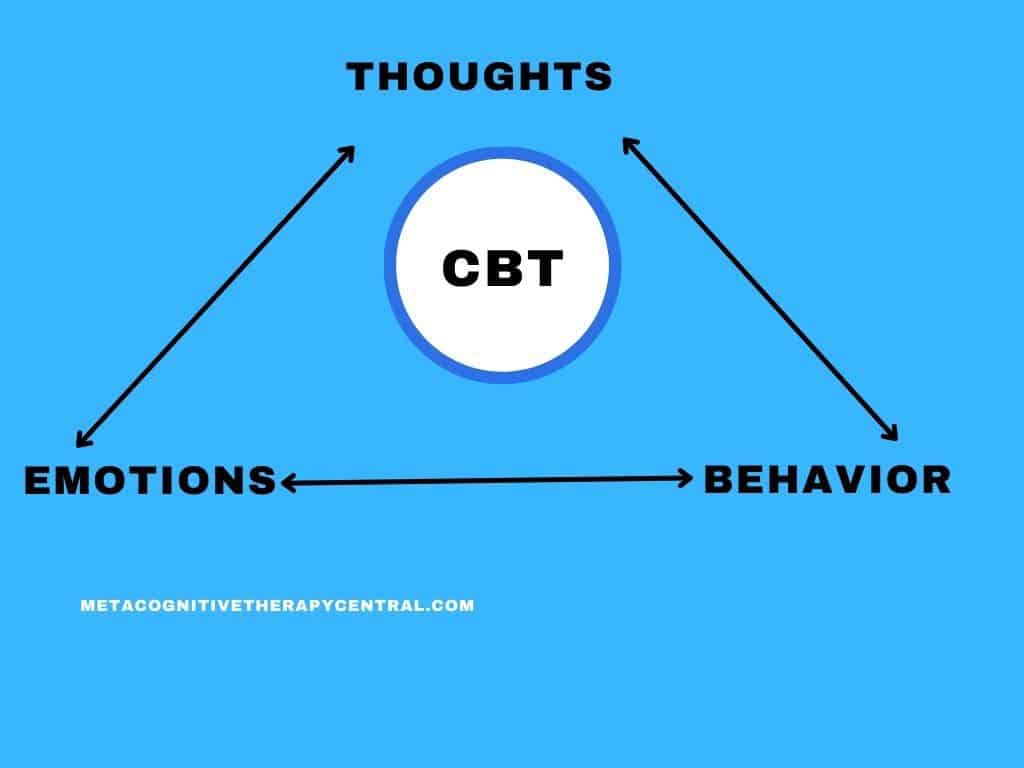
Generalized anxiety disorder (GAD) is one of the most frequently occurring anxiety disorders. GAD is highly impairing and rarely improves without treatment. Treatment results for GAD in the primary care system don’t show satisfactory results, which calls for new and better treatments.
Metacognitive therapy treats Generalized anxiety disorder more effectively than CBT, Exposure therapy, and Mindfulness. It is the only treatment that works to change metacognitive beliefs about worry to reduce it. Other therapies don’t recognize the importance of metacognitive beliefs in driving worry.
Results from studies of MCT for GAD show the following results:
•MCT for GAD produces very large post-treatment effect sizes
•Recovery rates are 70-80%
•MCT is superior to applied relaxation
•MCT is superior to therapies based on the Intolerance uncertainty model
•MCT is superior to CBT
•Treatment effects are stable up to 30 months
GAD increases the risk of developing other disorders simultaneously (comorbid disorders) like depression. For example, half the patients who come to the therapy with depression have Generalized anxiety disorder.

What is worry?
Worry is the core process of anxiety disorders. Almost all people experience worry during their lifetime, but in GAD, people perceive worry as extreme, chronic, and uncontrollable.
The topics of worry vary, from one’s job, exams, families, relationships, finances, health, and the worry itself. However, persistent worry often leads to stress, tension, nervousness, edginess, irritability, difficulty concentrating, insomnia, and muscle aches.
Since worry plays a significant role in Generalized anxiety disorder, treatment should reduce it effectively and indefinitely.
What defines a good psychological treatment?
Effective treatments for GAD (and any other psychiatric disorders) should correctly identify the mechanisms that maintain it. In the case of GAD, excessive and difficult-to-control worry is the driver of it. Therefore treatment must uncover what activates worry in the first place.
Why is it important to understand the mechanism behind GAD?
A clear understanding of the underlying mechanisms behind GAD will provide the following:
1) A clearer pathway to develop an effective treatment for GAD. Metacognitive therapy provides a clear theoretical framework for developing and maintaining GAD. According to Metacognitive therapy, metacognitive beliefs activate and maintain worry. Therefore it seems logical to challenge and change these beliefs to help patients recover from GAD. In comparison, mindfulness meditation doesn’t provide a theoretical reason for the development of GAD.
2) It becomes easier to test different techniques to see which therapy produces the best results. If we don’t know what we are treating, we won’t know why a specific technique works and whether it can be used effectively on all types of patients with GAD.
3) We can prevent future setbacks. Suppose a specific technique works for a patient. But if we don’t know why it works, we can’t confidently say that the GAD is cured permanently.
Therefore, a solid, theoretically grounded treatment approach is the biggest priority. This is one of the strengths of Metacognitive therapy for Generalized anxiety disorder.

In this post, you will learn
- How MCT and Mindfulness meditation, Exposure therapy, and CBT define Generalized anxiety disorder
- How effective these treatments are in treating Generalized anxiety disorder
- Similarities and differences between Metacognitive therapy and Mindfulness mediation, Exposure therapy, and CBT
Metacognitive therapy for Generalized anxiety disorder
The Metacognitive model indicates that beliefs about worry lead to worrying and other dysfunctional coping strategies that maintain generalized anxiety disorder.
According to MCT, Generalized anxiety (GAD) disorder develops when people believe that Worrying (Type I worry) is out of their control, and their anxious feelings are harmful. They then worry about worrying (type II worry), which exacerbates their anxiety symptoms. However, instead of reducing their worry, most people with GAD use thought suppression or distractions as an attempt to control their worry.
Unfortunately, forced strategies like thought-suppression, distraction, avoidance, or reassurance seeking always backfire, and anxiety symptoms persist instead of regulating themselves through our mind’s natural filter.
Metacognitive therapy’s theoretical model of GAD is based on the S-REF model. The S-REF suggests that dysfunctional thinking styles like worry and rumination block the mind’s emotion-regulating abilities.
GAD does not develop because of what thoughts people have (the content of thoughts), no matter how distressing those thoughts are. Rather, it is the way that people react to their negative thoughts that creates the problem.

How effective is Metacognitive therapy for GAD?
Metacognitive therapy for Generalized anxiety disorder is among the recent developments of cognitive therapies and has shown the highest effectiveness. 70-80% of patients recover fully after treatment and maintain this effect for up to 30 months.
A recent study measuring GAD patients 9 years after MCT treatment shows that 43% maintain their recovery, and 14% more recover. In total, after 9 years, 57% of patients recover from GAD after treatment with Metacognitive therapy.
Mindfulness meditation for Generalized anxiety disorder
The practice of Mindfulness meditation includes focusing on one’s breathing and accepting present moment experiences. The breath is used as an anchor to bring thoughts back to the present moment.
There has been a growing interest in using mindfulness meditation and similar techniques to treat psychological disorders.
Mindfulness meditation, which stems from Buddhist practices, has become increasingly popular as a psychological treatment approach. For example, mindfulness-based stress reduction (MBSR) and mindfulness-based cognitive therapy (MBCT) are used to treat depression.
Through the work of Jon Kabat-Zinn, mindfulness is associated with paying attention to the breath. This is to focus on the present moment without thinking about it. Paying attention also includes being aware of the thought stream without judging it and accepting things as they are.
Why Mindfulness meditation for GAD?
Recent suggestions include integrating Mindfulness and acceptance-based approaches with cognitive-behavioral therapies to improve the effects for GAD. Since people with GAD try to relieve their distress, it makes sense to use Mindfulness meditation as an alternative response to excessive worry.
In this post, I have explained the nuances of Mindfulness and how Mindfulness is different from MCT.
Does Mindfulness meditation work for GAD?
Although Mindfulness meditation has been used for both patients with GAD and depression, it is not clear what theories of psychological vulnerability it is built on. It is not clear how being aware in the present moment in a nonjudgmental way can provide experiences that clearly target the mechanisms that drive worry.
Mindfulness meditation can also be counterproductive when used by patients to avoid discomfort. However, this is typically the goal of therapists teaching Mindfulness meditation to patients who suffer from anxiety. Rather than learning to let the mind self-regulate, patients learn to avoid anxious feelings and control their thoughts.
For example, people who suffer from anxiety will use anchoring their attention to the breath to escape distressing thoughts and other “threats”. According to MCT, this is another form of thought control and avoidance strategy, which backfires and leads to more anxiety in the long term.
Besides, patients who practice Mindfulness meditation this way never get a chance to learn why their fears did not come true. So when the feared catastrophe does not happen, they attribute that to Mindfulness meditation and not the fact that it would not have occurred anyway.

Mindfulness meditation compared to MCT for GAD
Mindfulness meditation uses self-focused mindful procedures (meditation) like focusing on the breath. This may strengthen
self-consciousness, which contributes to stress vulnerability.
According to research, heightened self-awareness is linked to psychological vulnerability. Metacognitive therapy assumes that unflexible self-focused attention is linked to disorders like GAD, Social phobia, and depression.
MCT teaches GAD patients to reduce self-focused attention and instead focus their attention elsewhere. That way, they allow the mind to regulate itself from anxiety.
Besides, practicing Mindfulness meditation to escape anxiety won’t help patients to disconfirm their incorrect metacognitive beliefs about worry (that Worrying is harmful. worrying is out of my control).
It is possible to use Mindfulness meditation to challenge GAD patients’ metacognitive beliefs about worry. When Mindfulness meditation is purposefully used that way, it can teach patients to have a different relationship with their thoughts. That thoughts are not important, and they are brief.
For example, learning that worrying isn’t harmful and can be stopped will help GAD patients stand back from negative thoughts instead of worrying about them uncontrollably. That way, they will discover that nothing dangerous happens, and their anxiety will dissolve on its own.
But, still, there is a risk that Mindfulness meditation won’t directly modify these metacognitive beliefs. Therefore, using Mindfulness meditation as a therapy technique for GAD patients might not help them recover fully. And if they do, they are at high risk for setbacks because the mechanisms that drive worry (metacognitive beliefs) are not properly targeted.
| Metacognitive therapy | Mindfulness meditation | |
| Mechanism behind Generalized anxiety disorder | Metacognitive beliefs make us worry and lead to developing Generalized anxiety disorder | Unclear |
| Change technique in therapy | Detached mindfulness Flexible attention Verbal and behaviorally challenging metacognitive beliefs | Focusing on the breath Accepting the thoughts |
| Direct belief change | Yes – challenging and changing metacognitive beliefs verbally and through experiments | No |
| Relationship with anxiety | Anxiety is fleeting. Worry is controllable | when used in therapeutic settings: anxiety should be avoided |
Exposure therapy for Generalized anxiety disorder
The theory behind exposure therapy claims that people with GAD worry because they want to avoid emotionally disturbing issues and perceived threats. Worrying will also help them prepare for catastrophic situations.
But since worry hinders the mind in processing emotions fully, the person’s perception of danger grows out of portion. And because people with GAD avoid “threatening” situations, they have little chance of disconfirming their beliefs about these “dangerous” situations.
Therefore, Exposure therapy exposes patients to these “dangerous” situations. This helps patients with GAD to test out their predictions because if they don’t, they risk continuing worrying and thereby maintaining generalized anxiety disorder.
Why Exposure therapy for GAD?
If people with GAD avoid negative emotions and emotional avoidance negatively reinforces the worry process, Exposure therapy could be a good treatment for GAD. Exposure therapy consists of confronting physical triggers (exposure in vivo) or imagined triggers (exposure in sensu).
Exposure therapy has proved effective in, for example, treating specific phobia (the fear of snakes, spiders, heights, needles, etc.)
Exposure treatment teaches patients to attend to their emotions and learn that emotions are not dangerous. As a result, the anxiety response will diminish (habituation) because of prolonged exposure to the feared situation and decreased worrying. If done correctly, this type of exposure will change the patient’s belief about the “dangerous” situation (e.g., “this situation is not as dangerous as my anxiety had me believe“).
Does Exposure therapy for GAD work?
Research has found that the effects of Exposure therapy don’t differ significantly from Cognitive-behavioral therapy for GAD (about 50 % recovery rate).
These results could be because the theory behind Exposure therapy doesn’t sufficiently explain the mechanisms that maintain GAD.
In fact, research strongly suggests that worry doesn’t calm negative emotions but that worry causes significant negative emotions like anxiety.

Exposure therapy compared to MCT for GAD
The theory behind exposure therapy identifies worry as one of the drivers of Generalized anxiety disorder, which is also the case for MCT. But the role of worry in GAD differs completely in Exposure therapy and MCT:
- Worry in Exposure therapy serves to calm negative emotions
- Worry in MCT exacerbates negative emotions
There is no mention of changing metacognitive beliefs about worry in Exposure therapy. At least not directly. One could claim that exposure to potential feared outcomes does challenge metacognitive beliefs about the usefulness of worry and avoidance (that worry and avoidance don’t have the power to prevent catastrophic outcomes.)
Clearly, patients treated with Exposure therapy feel more competent when confronted with upcoming worries, also called increased self-efficacy. This type of competence could influence metacognitive beliefs and change them without addressing them directly. That way, GAD patients no longer believe that worry is out of their control and can easier stop worrying. They might also believe less in the assumption that worry can prevent catastrophic outcomes.
| Exposure therapy (worry exposure) | Metacognitive therapy (MCT) | |
| Mechanism behind Generalized anxiety disorder | Worry (to avoid negative emotions) Not disconfirming negative predictions about “threatening” situations | Metacognitive beliefs make us worry and lead to developing Generalized anxiety disorder |
| Change technique in therapy | Exposure to “threatening” situations with the aim of stopping worry | Detached mindfulness Flexible attention Verbal and behaviorally challenging metacognitive beliefs |
| Direct belief change | No. Only change of content of worry (that a specific situation was not dangerous) | Yes – challenging and changing metacognitive beliefs verbally and through experiments |
| Relationship with anxiety | “Threatening” situations are not dangerous | Anxiety is fleeting. Worry is controllable |
Cognitive-behavioral therapy for Generalized anxiety disorder
Cognitive-behavioral therapy (CBT) views GAD as being due to negative automatic thoughts and dysfunctional schemas (beliefs about oneself, others, and the world). People with Generalized anxiety disorder tend to overestimate the probability and severity of negative outcomes.
According to CBT, what people think about situations (Negative automatic thoughts and core beliefs) and how they behave influence how anxious they get.
Therefore, the aim of CBT for GAD is to challenge and change negative automatic thoughts and beliefs and help patients replace them with realistic thoughts to reduce symptoms of anxiety and improve functioning.
Examples of negative automatic thoughts:
Something bad has happened
I could get into an accident
I will fail
Examples of core beliefs:
I am a failure
The world is a dangerous place
Cognitive-behavioral therapy aims to help patients take a step back from their automatic thoughts and disconnect from worries.
Part of the treatment in CBT involves learning to detect the developing spiral of worry and to substitute alternative, more accurate perspectives.
Therapy techniques also include:
- Logical analysis.
- Examining the evidence and probabilities of the negative automatic thoughts.
- Labeling thinking errors (like black-and-white thinking, discounting the positive, self-blaming, etc.)
- Decatastrophizing.
- Generating alternative thoughts and beliefs.
Why CBT for GAD?
Research has shown that cognitive-behavioral therapy (CBT) is effective for GAD and is a well-recognized treatment method for anxiety disorders.

How well does CBT for GAD work?
CBT for generalized anxiety disorder has produced modest and disappointing outcomes (e.g., Fisher & Durham, 2000), especially lately, where CBT’s effect is declining. One of the weaknesses is that CBT uses many different treatment techniques combined but with a limited understanding of how each technique works.
Although traditional cognitive-behavioral therapy effectively treats GAD, more than 50% of the patients still maintain GAD symptoms after treatment.
The reason is that no one knows exactly how each CBT technique contributes to helping patients recover from GAD. Besides, CBT doesn’t clearly define the nature of GAD, which further leads to the lack of knowledge about what precisely improves it.
CBT compared with MCT for GAD
Research shows that both CBT and MCT are effective in reducing worry and anxiety symptoms in GAD both in the short- and long term. However, MCT has a better outcome in reducing worry than CBT, lasting up to two years after treatment.
A recent study that measured the result of MCT and CBT treatment for GAD after 9 years show the following results:
- 43 % of patients receiving MCT maintained their recovery after 9 years. (and 14 % recovered during those 9 years)
- 13 % of patients receiving CBT maintained their recovery after 9 years. (and 25 % recovered during those 9 years)
- 23,1 % of the CBT patients had setbacks and were rediagnosed with GAD
- 9,5 % of the MCT patients had setbacks and were rediagnosed with GAD
The differences between CBT and MCT outcomes reflect the amount of change they cause in the underlying mechanisms of Generalized anxiety disorder. CBT focuses on developing relaxation skills and challenging the content of worry, resulting in a 38% recovery rate. MCT challenges beliefs about worry; it deemphasizes the importance of thoughts and has a recovery rate of 57% that is well maintained over many years.
It seems that MCT better targets the mechanisms that cause GAD than CBT does. CBT might indirectly affect those mechanisms (metacognitive beliefs about worry), but since it doesn’t directly challenge them, the recovery rates stay lower than MCT. This also explains the higher relapse rates in CBT (23,1%).
| Cognitive-behavioral therapy (CBT) | Metacognitive therapy (MCT) | |
| Mechanism behind Generalized anxiety disorder | Negative automatic thoughts Schemas (distorted beliefs about oneself, others, and the world) | Metacognitive beliefs make us worry and lead to developing Generalized anxiety disorder |
| Change technique in therapy | Logical analysis of thoughts and beliefs, Cognitive restructuring (examining evidence of negative automatic thoughts) Generating alternative thoughts and beliefs Behavioral experiments to test thoughts, etc. | Detached mindfulness Flexible attention Verbal and behaviorally challenging metacognitive beliefs |
| Direct belief change | Yes – change of schemas (the content of thoughts) | Yes – learning that worry can be reduced |
| Relationship with anxiety | Anxiety needs to be controlled | Anxiety is fleeting. Reducing worry will reduce anxiety |
Conclusion
- Although Mindfulness meditation, Exposure therapy, and CBT reduce worrying and symptoms of Generalized anxiety disorder, they all lack knowledge about the cause behind worry. Additionally, it is difficult for these treatments to pinpoint the exact mechanisms that cause the improvement.
- Both CBT and Exposure therapy agree that worry causes and maintains GAD, but they don’t question what drives worry in the first place.
- Neither Mindfulness meditation nor Exposure therapy mentions the importance of changing cognitions (beliefs) for treatment success.
- Metacognitive therapy clearly defines the reason behind worrying (metacognitive beliefs), and treatment focuses on reducing worry AND changing metacognitive beliefs about worry.



